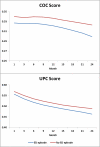Relationship Between Continuity of Ambulatory Care and Risk of Emergency Department Episodes Among Older Adults
- PMID: 27520592
- PMCID: PMC5292314
- DOI: 10.1016/j.annemergmed.2016.06.027
Relationship Between Continuity of Ambulatory Care and Risk of Emergency Department Episodes Among Older Adults
Abstract
Study objective: We determine whether visit patterns indicative of higher continuity are related to a lower risk of presenting at the emergency department (ED) among older adults.
Methods: This study was a survival analysis between 2011 and 2013 of a 20% random sample of fee-for-service Medicare beneficiaries aged 66 years or older. Ambulatory visit patterns were measured starting in 2011 for up to 24 months using 2 continuity metrics measured on a 0 to 1 scale-Continuity of Care (COC) score and the Usual Provider Continuity (UPC) score. The composite outcome of an ED episode was defined as occurrence of an ED visit with discharge home, an observation stay, or hospital admission. Time-dependent Cox proportional hazards regression models controlled for patient demographic characteristics, comorbidities, previous use, and regional factors, with censoring for death or occurrence of the composite outcome. In a secondary analysis, continuity was measured in the 12 months preceding an ED episode to test whether it was associated with type of ED episode.
Results: The relative rate of ED episodes decreased approximately 1% for every 0.1-point increase in the COC score (adjusted hazard ratio 0.99; 95% confidence interval 0.99 to 0.99; P<.001) and 2% for every 0.1-point increase in the UPC score (adjusted hazard ratio 0.98; 95% CI 0.98 to 0.99; P<.001), or up to a 10% lower rate between the lowest and highest COC score and a 20% lower rate for the UPC score. Among beneficiaries with an ED episode, higher continuity was associated with a 1% lower risk of observation stay but a 3% to 4% higher risk of hospital admission relative to an ED visit with discharge home.
Conclusion: Ambulatory visit patterns exhibiting more continuity were associated with a lower rate of ED utilization for older adults with fee-for-service Medicare coverage. The association of higher continuity with lower risk of ED use but differences in outcome when an ED visit does occur may reflect more appropriate referral to the ED when outpatient management is no longer adequate.
Copyright © 2016 American College of Emergency Physicians. Published by Elsevier Inc. All rights reserved.
Figures

References
-
- Niska R, Bhuiya F, Xu J, National Hospital Ambulatory Medical Care Survey . 2007 Emergency Department Summary. National health statistics reports; No 26. National Center for Health Statistics; Hyattsville, MD: 2010. - PubMed
-
- Shah MN, Glushak C, Karrison TG, et al. Predictors of emergency medical services utilization by elders. Acad Emerg Med. 2003;10(1):52–58. - PubMed
-
- McCusker J, Karp I, Cardin S, et al. Determinants of emergency department visits by older adults: a systematic review. Acad Emerg Med. 2003;10(12):1362–1370. - PubMed
-
- Pollack CV, Braunwald E. 2007 update to the ACC/AHA guidelines for the management of patients with unstable angina and non-ST-segment elevation myocardial infarction: implications for emergency department practice. Ann Emerg Med. 2008;51(5):591–606. - PubMed
MeSH terms
Grants and funding
LinkOut - more resources
Full Text Sources
Other Literature Sources

